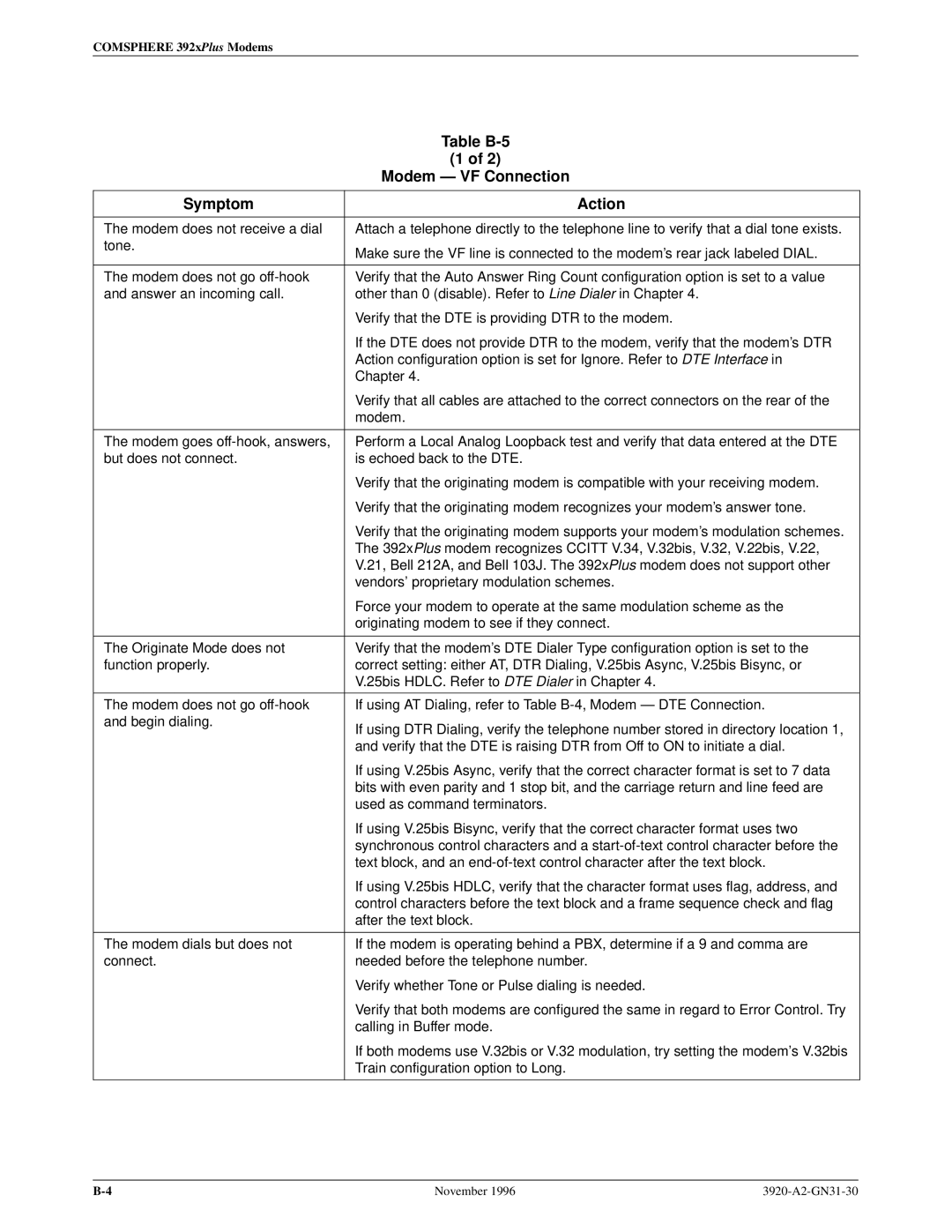
COMSPHERE 392xPlus Modems
| Table |
| (1 of 2) |
| Modem Ð VF Connection |
|
|
Symptom | Action |
|
|
The modem does not receive a dial | Attach a telephone directly to the telephone line to verify that a dial tone exists. |
tone. | Make sure the VF line is connected to the modem's rear jack labeled DIAL. |
| |
|
|
The modem does not go | Verify that the Auto Answer Ring Count configuration option is set to a value |
and answer an incoming call. | other than 0 (disable). Refer to Line Dialer in Chapter 4. |
| Verify that the DTE is providing DTR to the modem. |
| If the DTE does not provide DTR to the modem, verify that the modem's DTR |
| Action configuration option is set for Ignore. Refer to DTE Interface in |
| Chapter 4. |
| Verify that all cables are attached to the correct connectors on the rear of the |
| modem. |
|
|
The modem goes | Perform a Local Analog Loopback test and verify that data entered at the DTE |
but does not connect. | is echoed back to the DTE. |
| Verify that the originating modem is compatible with your receiving modem. |
| Verify that the originating modem recognizes your modem's answer tone. |
| Verify that the originating modem supports your modem's modulation schemes. |
| The 392xPlus modem recognizes CCITT V.34, V.32bis, V.32, V.22bis, V.22, |
| V.21, Bell 212A, and Bell 103J. The 392xPlus modem does not support other |
| vendors' proprietary modulation schemes. |
| Force your modem to operate at the same modulation scheme as the |
| originating modem to see if they connect. |
|
|
The Originate Mode does not | Verify that the modem's DTE Dialer Type configuration option is set to the |
function properly. | correct setting: either AT, DTR Dialing, V.25bis Async, V.25bis Bisync, or |
| V.25bis HDLC. Refer to DTE Dialer in Chapter 4. |
|
|
The modem does not go | If using AT Dialing, refer to Table |
and begin dialing. | If using DTR Dialing, verify the telephone number stored in directory location 1, |
| |
| and verify that the DTE is raising DTR from Off to ON to initiate a dial. |
| If using V.25bis Async, verify that the correct character format is set to 7 data |
| bits with even parity and 1 stop bit, and the carriage return and line feed are |
| used as command terminators. |
| If using V.25bis Bisync, verify that the correct character format uses two |
| synchronous control characters and a |
| text block, and an |
| If using V.25bis HDLC, verify that the character format uses flag, address, and |
| control characters before the text block and a frame sequence check and flag |
| after the text block. |
|
|
The modem dials but does not | If the modem is operating behind a PBX, determine if a 9 and comma are |
connect. | needed before the telephone number. |
| Verify whether Tone or Pulse dialing is needed. |
| Verify that both modems are configured the same in regard to Error Control. Try |
| calling in Buffer mode. |
| If both modems use V.32bis or V.32 modulation, try setting the modem's V.32bis |
| Train configuration option to Long. |
|
|
November 1996 |
